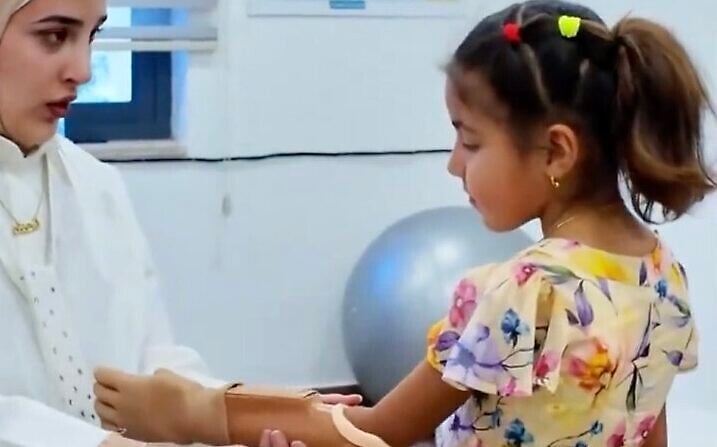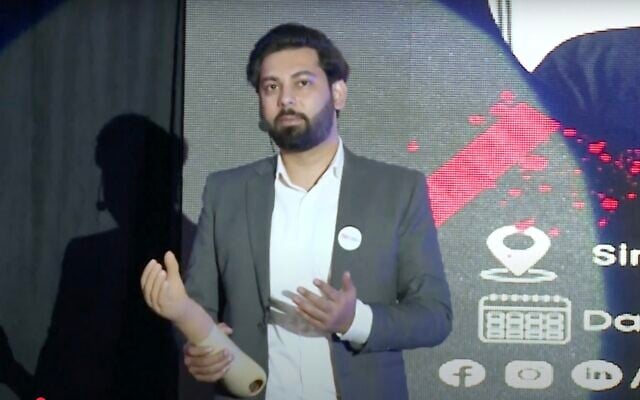



KARACHI, Pakistan — As soon as eight-year-old Sidra Al Bordeeni returned from the clinic with her prosthetic arm, she jumped on a bicycle in the Jordanian refugee camp where she lives, riding for the first time since a missile strike in Gaza took her arm a year ago.
Sidra was injured while sheltering at Nuseirat School, one of several Gaza schools converted into makeshift refuges for displaced Gazans. Israel has carried out strikes on such sites several times, saying that Hamas uses them as command centers. In July 2024, it hit the UNRWA’s al-Jaouni school in the Nuseirat refugee camp, with the IDF saying it had taken many steps to mitigate harm to civilians, including using aerial surveillance and other intelligence.
Her mother, Sabreen Al Bordeeni, said Gaza’s collapsed health services and the family’s inability to leave at the time made it impossible to save her hand.
“She’s out playing, and all her friends and siblings are fascinated by her arm,” Al Bordeeni said on the phone, repeatedly thanking God for this day. “I can’t express how grateful I am to see my daughter happy.”
The arm was built over 4,000 kilometers away in Karachi by Bioniks, a Pakistani company that uses a smartphone app to take pictures from different angles and create a 3D model for custom prosthetics.
CEO Anas Niaz said the social enterprise startup had fit more than 1,000 custom-designed arms inside Pakistan since 2021 — funded through a mix of patient payments, corporate sponsorship, and donations — but this was its first time providing prosthetics to those impacted in conflict.
Sidra and three-year-old Habebat Allah, who lost both her arms and a leg in Gaza, went through days of remote consultations and virtual fittings. Then Niaz flew from Karachi to Amman to meet the girls and make his company’s first overseas delivery.
Israel has allowed some wounded Gazans to exit the Strip via the Rafah border crossing from Egypt, from where they can go on to get treatment.
Sidra’s device was funded by Mafaz Clinic in Amman, while donations from Pakistanis paid for Habebat’s. Mafaz CEO Entesar Asaker said the clinic partnered with Bioniks for its low costs, remote solutions and ability to troubleshoot virtually.
Niaz said each prosthetic arm costs about $2,500, significantly less than the $10,000 to $20,000 for alternatives made in the United States.
While Bioniks’ arms are less sophisticated than US versions, they provide a high level of functionality for children, and their remote process makes them more accessible than options from other countries, such as Turkey and South Korea.
“We plan on providing limbs for people in other conflict zones too, like Ukraine, and become a global company,” Niaz said.
Globally, most advanced prosthetics are designed for adults and rarely reach children in war zones, who need lighter limbs and replacements every 12–18 months as they grow.
Niaz said they were exploring funding options for Sidra and Habebat’s future replacements, adding the cost wouldn’t be too high.
“Only a few components would need to be changed,” he said. “The rest can be reused to help another child.”
Bioniks occasionally incorporates popular fictional characters into its children’s prosthetics such as Marvel’s Iron Man or Disney’s Elsa, a feature Niaz said helps with emotional acceptance and daily use.
Gaza now has around 4,500 new amputees, on top of 2,000 existing cases from before the war, many of them children, making it one of the highest child-amputation crises per capita in recent history, the UN humanitarian agency OCHA said in March.
An April study by the Palestinian Bureau of Statistics found at least 7,000 children have been injured since October 7, 2023, when the Palestinian terror group Hamas led a devastating invasion of southern Israel that killed 1,200 people, triggering the war.
The Hamas-run Gaza health ministry says more than 57,000 people in the Strip have been killed or are presumed dead in the fighting so far, though the toll cannot be verified and does not differentiate between civilians and fighters.
Israel says it has killed some 20,000 combatants in battle as of January and another 1,600 terrorists inside Israel during the October 7 onslaught. Israel has said it seeks to minimize civilian fatalities and stresses that Hamas uses Gaza’s civilians as human shields, fighting from civilian areas including homes, hospitals, schools, and mosques.
The World Health Organization has said Gaza’s health system is “on its knees” with Israel’s border closures drying up critical supplies, meaning the wounded cannot access specialized care, especially amid waves of wounded patients.
“Where it’s nearly impossible for healthcare professionals and patients to meet, remote treatment bridges a critical gap, making assessments, fittings, and follow-up possible without travel or specialized centers,” said Asadullah Khan, Cclinic manager at ProActive Prosthetic in Leeds, UK, which provides artificial limbs and support for trauma patients.
Bioniks hopes to pioneer such solutions on a large scale but funding remains a roadblock and the company is still trying to form viable partnerships.
Sidra is still adjusting to her new hand, on which she now wears a small bracelet. For much of the past year, when she wanted to make a heart, a simple gesture using both hands, she would ask someone else to complete it. This time, she formed the shape herself, snapped a photo, and sent it to her father, who is still trapped in Gaza.
“What I’m looking forward to most is using both my arms to finally hug my father when I see him,” she said.

